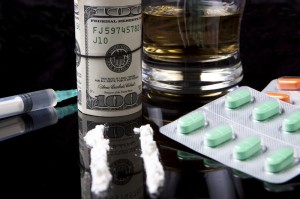Poly-Drug Abuse

Table of Contents
Recovering from drug abuse is much easier when only one drug is involved, but in reality, most substance abusers have problems with more than one intoxicant. For instance, many individuals who use cocaine or meth for their stimulant effects will turn to alcohol or tranquilizers when they need to come down off a high. People who take hallucinogenic drugs may combine mind-altering chemicals in order to intensify their effects. The Substance Abuse and Mental Health Administration reports that in 2008, poly-drug abuse accounted for over half (55 percent) of reported admissions to addiction treatment facilities.
Whether you’re taking multiple drugs to achieve a specific state of mind, or just because there happen to be a lot of drugs available, the results may be completely different than what you expect. Illegal drugs like heroin, cocaine and meth can interact with alcohol, prescription drugs and medications in dangerous, even fatal, ways. If you or someone you love is engaged in poly-drug abuse, a drug rehab program could mean the difference between life and death.
 What Is Poly-Drug Abuse?
What Is Poly-Drug Abuse?
Poly-drug abuse may mean different things to different users. For some, it means taking multiple drugs at the same time, so that you start to experience the effects of one drug before the other wears off. For others, it means using one drug when another substance isn’t available. Poly-drug abuse doesn’t necessarily imply that you’re chemically dependent on every drug you take. But if you take multiple drugs together on a regular basis, you may develop a disorder called “poly-substance dependence,” a psychological addiction to a combination of intoxicants.
Poly-drug abuse could potentially involve thousands of different combinations of chemicals. However, the journal Addiction identifies four major categories that are encountered at emergency treatment facilities and addiction centers:
- Narcotics combined with other mind-altering drugs and alcohol
- Methadone use combined with the use of other drugs and alcohol
- Alcohol abuse combined with the abuse of other drugs
- The abuse of multiple narcotics
More recently, prescription drug abuse has become one of the leading sources of poly-drug abuse in the United States. Multi-drug abuse may occur when someone with a legitimate prescription takes alcohol or a street drug at the same time, or when a prescription drug is abused along with illicit drugs and/or alcohol.
In a study of 4,580 college students, the Journal of Studies on Alcohol and Drugs found that 12.1 percent of students had used alcohol with prescription pain medication, stimulants or sedatives within the past 12 months. As a central nervous system depressant, alcohol significantly increases the risk of deadly side effects when it’s taken with other depressants, like opioid pain medications or heroin.
People use multiple drugs together for a variety of reasons. Some users combine drugs in order to achieve a specific mental state, while others take one drug to balance out the effects of the other. According to Health Education Research, some of the most common reasons for using multiple drugs include:
- To intensify the effects of drug use
- To prolong the high of a primary drug
- To prevent the negative side effects of a substance
- To feel “normal” again after taking a psychoactive drug
Poly-drug abuse may be deliberate or unintentional. Street drugs like heroin, cocaine or meth are often “cut” with stimulants or medications in order to alter their effects or to extend the supply. Marijuana may be laced with hallucinogenic drugs like PCP to produce a mind-altering effect. In the world of illegal drugs, you can never be sure what you’re getting.
In some cases, users take one drug because their preferred drug isn’t available. Often the substitute drug will either reproduce the effects of the primary substance or prevent withdrawal symptoms from the preferred drug. For example, a heroin addict might drink alcohol or take another opiate, such as codeine or methadone, when he or she doesn’t have access to heroin.
What Makes Poly-Drug Abuse So Deadly?
 Regardless of the reasons for taking more than one drug at once, the consequences of abusing multiple drugs make this practice extremely risky. When you take more than one illicit drug at the same time, you may intensify each drug’s effects. Taking several depressants at the same time, such as alcohol and morphine or heroin, can result in deadly respiratory depression, heart failure, coma and death. Alternatively, taking drugs that mask each others’ effects can increase the risk of an overdose. When heroin (a depressant) and cocaine (a stimulant) are taken together, the user may not realize that he or she has taken too much of both drugs until it’s too late.
Regardless of the reasons for taking more than one drug at once, the consequences of abusing multiple drugs make this practice extremely risky. When you take more than one illicit drug at the same time, you may intensify each drug’s effects. Taking several depressants at the same time, such as alcohol and morphine or heroin, can result in deadly respiratory depression, heart failure, coma and death. Alternatively, taking drugs that mask each others’ effects can increase the risk of an overdose. When heroin (a depressant) and cocaine (a stimulant) are taken together, the user may not realize that he or she has taken too much of both drugs until it’s too late.
Illegal drugs can interfere with prescription medications, either by increasing their potency or by interfering with their actions. A study published in the Journal of Forensic Sciences found that in fatal overdoses involving morphine, a significant percentage of users who had high concentrations of morphine in their blood also had high concentrations of certain antidepressants.
Synthetic designer drugs like bath salts, incense and Ecstasy often have unknown physical and psychological side effects. These drugs are made in illegal underground laboratories, where production standards are not enforced and ingredients may vary from one batch to the next. When you take these drugs in combination with other hallucinogenic drugs, stimulants or alcohol, it’s impossible to know exactly how they’ll affect your body and brain.
- Careful toxicology screening in the assessment stage to determine which drugs the patient is taking. With many admissions, the patient herself may not know what’s in her system.
- Prioritization during the detox phase. In the beginning of detoxification, drugs like alcohol and barbiturates should take priority, as these sedatives are most likely to cause fatal consequences.
- Counseling and other psychosocial therapies in the rehabilitation phase to help patients address the behaviors and thought patterns that led them to multiple addictions.
- Medication therapy to minimize withdrawal symptoms and lessen the craving for alcohol, opiates or stimulants.
- Treatment for co-occurring mental health disorders, such as depression, bipolar disorder or post-traumatic stress disorder
- Alternative therapies like acupuncture to reduce cravings and promote relaxation.
At Axis, we’re aware of the scope of the problem of poly-drug abuse. Because we offer individually tailored addiction treatment plans, we’re uniquely positioned to help each client recover from his or her disease. We offer a full range of recovery services, including residential and outpatient treatment programs, detoxification services and specialized treatment for co-occurring disorders. Our residential treatment center provides intensive rehabilitation in a secure, confidential setting, where you can be closely monitored by professionals 24 hours a day, seven days a week.
Recovering from poly-drug abuse isn’t easy. When your body and brain have become dependent on more than one drug, it can seem like there’s no way to escape the trap of addiction but there is hope. The time you devote to recovery will pay off tremendously when you start a new, sober life here at Axis.

